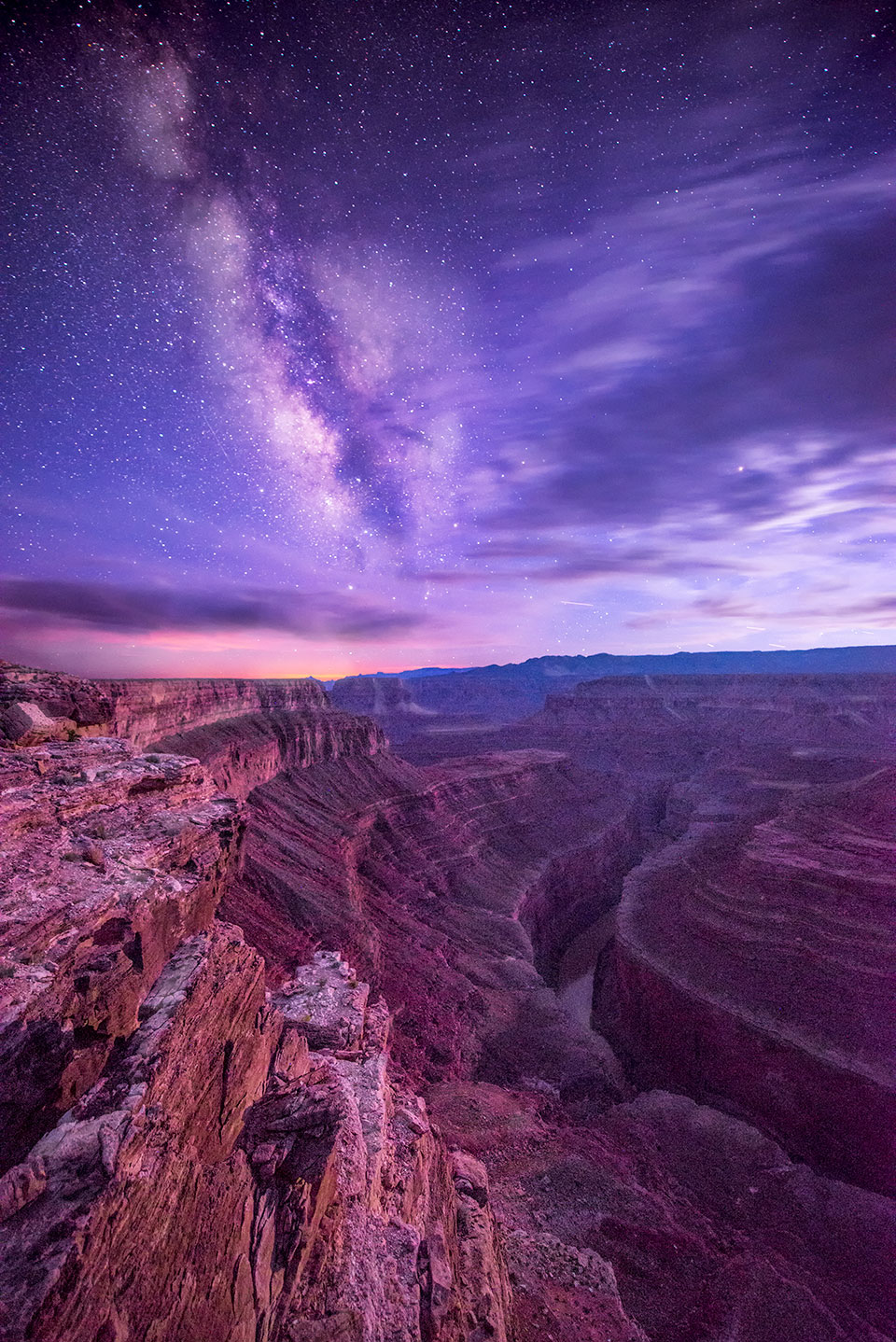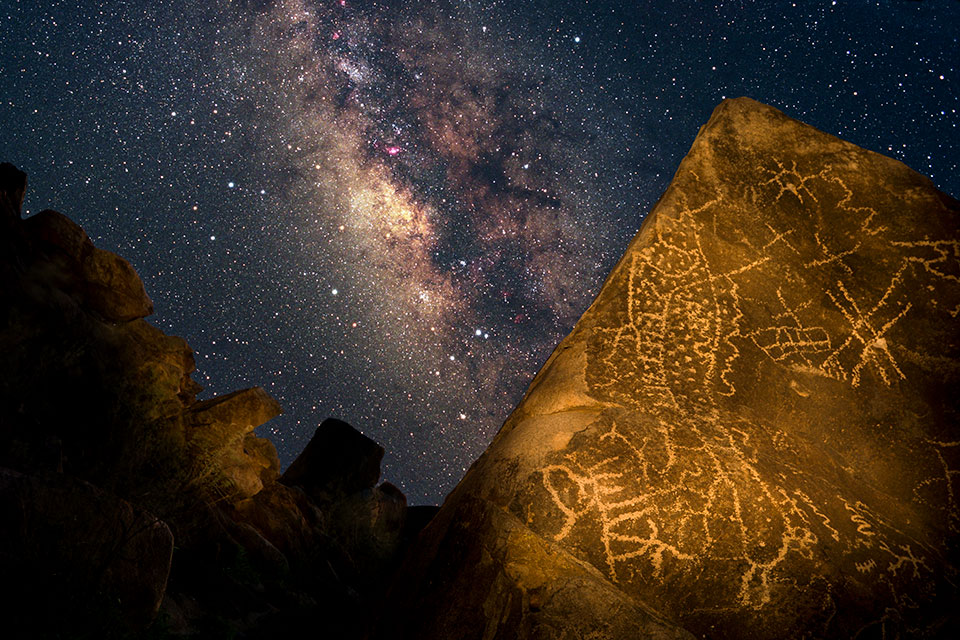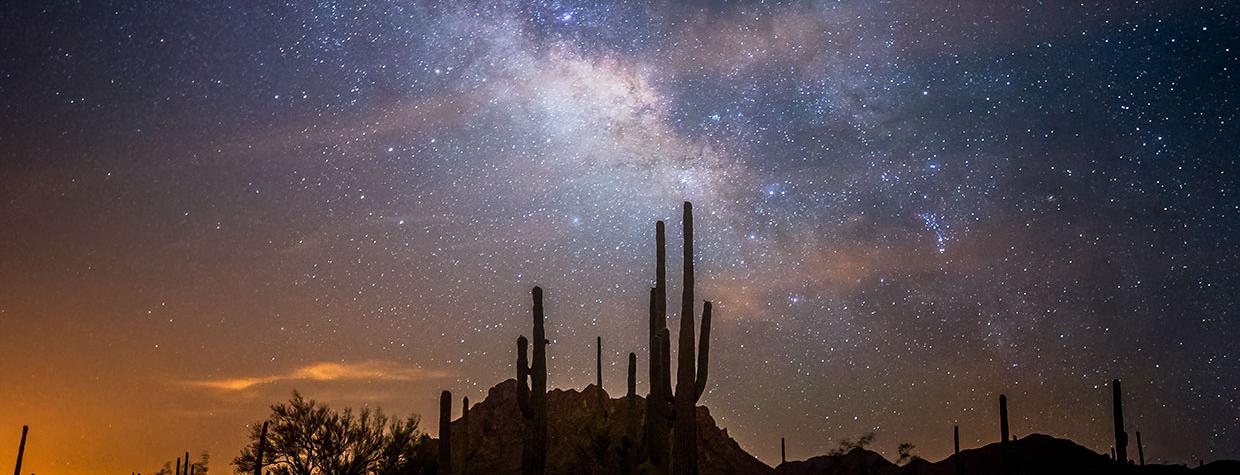Stars were so dense, there was hardly space for sky.
I was late coming up the Bright Angel Trail. It wasn’t on purpose until I realized that by not rushing, I’d walk the last part of the trail in starlight. A ranger caught up with me at the edge of dark, concerned that I was the only hiker still on the trail. But she understood my wish to walk in full night and continued on.
I’m used to night in wild places. Often finding myself hiking, or on the back of a horse, after sundown — because I start a trail too late in the day, or I hike too slowly, or night simply arrives — I usually enter it with curiosity. Night is the dimension of wilderness where wildflowers are replaced by stars. Because this means that under a clear night sky I’m more apt to look up than down, being on horseback is a good idea. Theoretically, the horse is paying attention to the trail.
To be in a wild place on a clear night of no moon is like finding my own place among the stars. Nothing separates the sky and me.
There was a time when this experience was natural to all people on Earth — a time when stars were so present, they served as guides on both land and sea. Stars told us where we were; they led us to our destinations. They told us when to plant and when to harvest; they dictated the time of ceremonies. They inspired mathematics, science, art, poetry, music and religion. Among Indigenous tribes, oral cultures built of stars are passed from generation to generation.
Navajo and other tribal astronomers find their own histories in the night skies. Constellations hold their stories, some of which are available to us all. Others, according to Dr. Nancy Maryboy, the Cherokee and Navajo founder of the Indigenous Education Institute, are considered sacred knowledge, to be passed on to tribal members only by elders or medicine people.
The shape of the hogan mirrors the dome of the sky, serving as a reminder that the sky is always present and that starlight preceded all life processes. Navajo educator Dr. David Begay says the night sky is not something that can be separated from Navajo life — that we are made of stars, and stars are eternal. While the boundaries of Navajoland are delineated by the sacred mountains, the Navajo people, forever aware that earth forms can change, trust in the permanence of the stars.
In 2021, because of the pandemic, Grand Canyon National Park’s Star Party, held over eight days every June, was virtual. All of that year’s presentations are available on the park’s website, affording any of us an experience with Maryboy and Begay, co-authors of the book Sharing the Skies: Navajo Astronomy. Their presentation, with its gorgeous star maps and their own deep knowledge, makes for a powerful program.

Night matters. Life on Earth evolved with night and day; both are encoded in the DNA of plants and animals, and both are necessary for the health of everything that lives. (Or, perhaps, everything not living full time in a cave.) But if the night sky once served as an infallible guide, that was before the world got lit up. Before satellites in space sent back photos of great blobs of light all over the globe. Before cities across the planet sent so much light into the night sky that the sky virtually disappeared. When skyscraping buildings everywhere are lit in a myriad of colors, we may be momentarily dazzled, but at the cost of what the night sky once offered.
Even from many wild places, the glow of big cities is out there, on the horizon. I live in a rural area, but nightglow reaches me from a city 40 miles and a mountain range away — and it isn’t even a big city. Distant light does not make me feel less lonely. It makes me feel put upon, denied my rightful heritage of stars.
The invention of the electric light bulb opened extraordinary possibilities. But as light bulbs have become cheaper (and ubiquitous), they often have erased the glorious, necessary world of the night sky. Light pollution is growing at twice the rate of the Earth’s population yet remains relatively unexplored compared to air and water pollution. It can be seen from space. It penetrates wild country. It keeps us from the stars while wreaking havoc on much of earthly life.
Birds migrating or hunting at night wander off course and toward the lit-up nighttime landscape of cities. Millions, colliding with needlessly illuminated buildings and towers and monuments, die. Many, once cued by seasonal schedules, are lured by light into migrating too early or too late, missing ideal climate conditions for nesting and foraging. Predators exploit this attraction to their advantage, which affects food levels in unanticipated ways. Nocturnal animals, normally active at night and resting by day, must certainly wonder what on Earth is going on.
Artificial lights provide a fatal attraction for insects drawn to light. In turn, declining insect populations affect species relying on them for food or pollination. Glare from artificial lights affects wetland habitats and the nighttime croaking of frogs and toads. Because that croaking is part of their breeding ritual, populations of both are suffering. Sea turtles, hatching on beaches at night, naturally find their way to the sea via the bright horizons over the ocean. Artificial light draws them away from the ocean, causing the death of millions of hatchlings every year.
Arizona, and much of the rest of the world, owes a focus on a better night sky to Dr. Tim Hunter, a Tucson radiologist and amateur astronomer. In 1985, Hunter, who remembers seeing the Milky Way in the 1950s and ’60s from his childhood home in suburban Chicago, placed a large telescope on a grassland plateau 40 miles southeast of Tucson. This was not the view he’d had as a kid. But it was a kind of epiphany: As bad lighting around Tucson interfered with his stargazing, he realized the night sky was a fragile resource.
His quest to fix the night led him to Kitt Peak National Observatory’s Dark Sky Office, where he met astronomer Dr. David Crawford and engineer Bill Robinson. The latter was instrumental in measuring lighting levels around Tucson and Pima County and promoting lighting ordinances in Arizona. It was in working with Robinson, Hunter tells me, that he learned that “light pollution is a relatively easy environmental problem to solve, but nobody was doing anything about it.”

The second part is no longer true. Hunter, Crawford and Robinson formed a nonprofit organization, the International Dark-Sky Association, to combat light pollution. Incorporated in Tucson in 1987, the IDA has since spread across the world. There are now official Dark Sky Places on every continent but Antarctica. All earned their designations through a rigorous application process in which applicants must demonstrate robust community support for dark-sky protection. There are various categories of Dark Sky Places; one is International Dark Sky Parks, of which Arizona boasts two national parks (Grand Canyon and Petrified Forest), several other National Park Service sites and two state parks
(Kartchner Caverns and Oracle). The other designations include International Dark Sky Reserves, Sanctuaries and Communities, along with Urban Night Sky Places. In October 2001, Flagstaff became the world’s first International Dark Sky City, although Flagstaff was ahead of the game, creating regulations to ensure the health and presence of its night sky years before the IDA was formed. Altogether, Arizona boasts 19 IDA-certified places.
The awareness wrought by the IDA has afforded other successes. Many cities now turn off the lights on their buildings during migration seasons. Others have adopted lights focusing downward rather than up, into the sky. Some successes may have little to do with the IDA, although, because the group does such a terrific job of outreach, who knows? In Paris, The New York Times reported, young athletes practice the sport of parkour — running, climbing and jumping over urban obstacles — to turn off shop signs at night in an effort to fight light pollution.
Parkour is not mentioned in the IDA’s most recent report, Artificial Light at Night: State of the Science 2022, but not much else is missing. The report summarizes “the current state of knowledge about how the widespread and growing use of artificial light at night interacts with six key topics”: the night sky, wildlife and ecology, human health, public safety, energy security and climate change, and social justice. While the report is “intended to be useful to those seeking to broaden their understanding of research on the causes and consequences of artificial light at night,” it avoids scientific jargon, making it useful for any of us wanting to do something. It can be downloaded for free from the IDA’s website.
That website is, in fact, a marvelous place to visit for anyone interested in the night sky. A recent profile of a Turkish-born English artist, lighting designer Kerem Asfuroglu, explores the human relationship with light and darkness. In a work of installation art, Penumbrella, Asfuroglu shows how light pollution in central London is so extreme that wasted light can be used to charge solar panels at night. London is hardly Arizona, but when it comes to light pollution, attention anywhere seems important in the attempt to retrieve our starry night sky everywhere. There is, after all, only one sky above us.
I ask the IDA’s CEO and executive director, Ruskin Hartley, why I so rarely see light pollution efforts by major environmental organizations concerned with every other sort of pollution. “The challenge is that light pollution is not well known,” Hartley says. “I think we will see it accelerate over the coming years. It’s my plan to help it along the path.”
Light pollution was not an issue as I came up the Bright Angel Trail. While it never occurred to me to pick out constellations or particular stars, I was so awed by their mass that I probably couldn’t have separated any from the others if I’d tried. I’m sure my brother, who navigates by the stars, could have. Other star watchers might have. If I hadn’t been on a trail, and close to the trail’s end — if I had been lost — I would have looked for the North Star. I would have found my way.
Tucson sixth-grader Xander Clinkingbeard wrote a poem called Saving the Desert’s Dark Skies after watching an IDA presentation at the Arizona-Sonora Desert Museum. The IDA has it posted on its website. In his second verse, Xander quotes Vincent van Gogh: The sight of the stars makes me dream.
Me, too, Xander.

